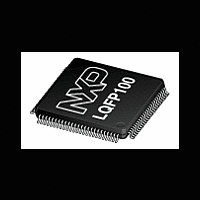LPC2364HBD100 NXP Semiconductors, LPC2364HBD100 Datasheet - Page 16

LPC2364HBD100
Manufacturer Part Number
LPC2364HBD100
Description
LPC2364HBD100/LQFP100/TRAYBDP/
Manufacturer
NXP Semiconductors
Series
LPC2300r
Datasheet
1.LPC2364FBD100551.pdf
(59 pages)
Specifications of LPC2364HBD100
Core Processor
ARM7
Core Size
16/32-Bit
Speed
72MHz
Connectivity
CAN, Ethernet, I²C, Microwire, SPI, SSI, SSP, UART/USART, USB
Peripherals
Brown-out Detect/Reset, DMA, I²S, POR, PWM, WDT
Number Of I /o
70
Program Memory Size
128KB (128K x 8)
Program Memory Type
FLASH
Ram Size
34K x 8
Voltage - Supply (vcc/vdd)
3 V ~ 3.6 V
Data Converters
A/D 6x10b; D/A 1x10b
Oscillator Type
Internal
Operating Temperature
-40°C ~ 125°C
Package / Case
100-LQFP
Processor Series
LPC23
Core
ARM7TDMI-S
3rd Party Development Tools
MDK-ARM, RL-ARM, ULINK2, SAB-TFBGA100
Lead Free Status / RoHS Status
Lead free / RoHS Compliant
Eeprom Size
-
Lead Free Status / Rohs Status
Details
Available stocks
Company
Part Number
Manufacturer
Quantity
Price
Company:
Part Number:
LPC2364HBD100
Manufacturer:
NXP
Quantity:
479
Company:
Part Number:
LPC2364HBD100
Manufacturer:
NXP Semiconductors
Quantity:
10 000
Part Number:
LPC2364HBD100
Manufacturer:
NXP/恩智浦
Quantity:
20 000
Company:
Part Number:
LPC2364HBD100,551
Manufacturer:
NXP Semiconductors
Quantity:
10 000
Part Number:
LPC2364HBD100,551
Manufacturer:
NXP/恩智浦
Quantity:
20 000
NXP Semiconductors
[8]
[9]
[10] Pad provides special analog functionality.
[11] Pad provides special analog functionality.
[12] Pad provides special analog functionality.
[13] Pad provides special analog functionality.
[14] Pad provides special analog functionality.
7. Functional description
LPC2364_65_66_67_68_6
Product data sheet
Pad provides special analog functionality.
When the main oscillator is not used, connect XTAL1 and XTAL2 as follows: XTAL1 can be left floating or can be grounded (grounding
is preferred to reduce susceptibility to noise). XTAL2 should be left floating.
7.1 Architectural overview
The LPC2364/65/66/67/68 microcontroller consists of an ARM7TDMI-S CPU with
emulation support, the ARM7 local bus for closely coupled, high-speed access to the
majority of on-chip memory, the AMBA AHB interfacing to high-speed on-chip peripherals,
and the AMBA APB for connection to other on-chip peripheral functions. The
microcontroller permanently configures the ARM7TDMI-S processor for little-endian byte
order.
The LPC2364/65/66/67/68 implements two AHB in order to allow the Ethernet block to
operate without interference caused by other system activity. The primary AHB, referred
to as AHB1, includes the VIC and GPDMA controller.
The second AHB, referred to as AHB2, includes only the Ethernet block and an
associated 16 kB SRAM. In addition, a bus bridge is provided that allows the secondary
AHB to be a bus master on AHB1, allowing expansion of Ethernet buffer space into
off-chip memory or unused space in memory residing on AHB1.
In summary, bus masters with access to AHB1 are the ARM7 itself, the GPDMA function,
and the Ethernet block (via the bus bridge from AHB2). Bus masters with access to AHB2
are the ARM7 and the Ethernet block.
AHB peripherals are allocated a 2 MB range of addresses at the very top of the 4 GB
ARM memory space. Each AHB peripheral is allocated a 16 kB address space within the
AHB address space. Lower speed peripheral functions are connected to the APB. The
AHB to APB bridge interfaces the APB to the AHB. APB peripherals are also allocated a
2 MB range of addresses, beginning at the 3.5 GB address point. Each APB peripheral is
allocated a 16 kB address space within the APB address space.
The ARM7TDMI-S processor is a general purpose 32-bit microprocessor, which offers
high performance and very low power consumption. The ARM architecture is based on
Reduced Instruction Set Computer (RISC) principles, and the instruction set and related
decode mechanism are much simpler than those of microprogrammed complex
instruction set computers. This simplicity results in a high instruction throughput and
impressive real-time interrupt response from a small and cost-effective processor core.
Pipeline techniques are employed so that all parts of the processing and memory systems
can operate continuously. Typically, while one instruction is being executed, its successor
is being decoded, and a third instruction is being fetched from memory.
Rev. 06 — 1 February 2010
LPC2364/65/66/67/68
Single-chip 16-bit/32-bit microcontrollers
© NXP B.V. 2010. All rights reserved.
16 of 59















